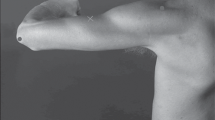Abstract
This article reviews the current techniques of surface electromyography (SEMG) assessment. Discussed are static, dynamic, and combination assessment techniques and the rational for their use.
Similar content being viewed by others
REFERENCES
Basmajian, J. (1967). Muscles alive: Their function revealed by Electromyography (2nd ed.) Baltimore: Williams and Wilkins.
Basmajian, J., & DeLuca, C. (1985). Muscles alive: Their function revealed by electromyography (5th ed.) Baltimore: Williams and Wilkins.
Budzynski, T., Stoyva, J., Adler, C., & Mullaney, D. (1973). EMG biofeedback and tension headache: A controlled outcome study. Psychosomatic Medicine, 35, 484-496.
Chu-Andrews, J., & Johnson, R. J. (1986). Electrodiagnosis: An anatomical and clinical approach. Philadelphia: J. B. Lippincott Company.
Colloca, C. J., & Keller, T. S. (2001). Electromyographic reflex responses to mechanical force, manually assisted spinal manipulative therapy. Spine, 26, 1117-1124.
Cram, J. R. (1986). Clinical EMG: Muscle scanning and diagnostic manual for surface recordings. Seattle, WA: Clinical Resources.
Cram, J. R., & Engstrom, D. (1986). Patterns of neuromuscular activity in pain and non-pain patients. Clinical Biofeedback and Health, 9, 55-61.
Cram, J., Kasman, G., & Holtz, J. (1998). Introduction to surface electromyography. Maryland: Aspen Publishers.
Donaldson, C. C. S., & Donaldson, M. (1990). Multi-channel EMG assessment and treatment techniques. In J. Cram (Ed.), Clinical EMG for surface recordings (Vol. 2). Seattle, WA: Clinical Resources.
Donaldson, C. C. S., Skubick, D., Clasby, R., & Cram, J. (1994). The evaluation of trigger-point activity using dynamic EMG techniques. American Journal of Pain Management, 4, 118-122.
Donaldson, C. C. S., Snelling, L. S., MacInnis, A. L., Sella, G. E., & Mueller, H. H. (2002). Diffuse muscular coactivation (DMC) as a potential source of pain in fibromyalgia—Part 1. NeuroRehabilitation, 17.
Keller, T. S., & Colloca, C. J. (2000). Mechanical force spinal manipulation increases trunk muscle strength assessed by electromyography: A comparative clinical trial. Journal of Manipulative Physiological Therapy, 23, 585-595.
Leonard, C., Moritani, H., Hirschfeld, & Forssberg, H. (1990). Deficits in reciporal inhibition of children with cerebral palsy as revealed by H reflex testing. Developmental Medicine and Child Neurology, 32, 974-984.
Meyer, J. J. (1995). The validity of thoracolumbar paraspinal scanning EMG as a diagnostic test: An examination of the current literature. Journal of Manipulative Physiological Therapy, 18, 482-484.
Sella, G. E. (2000a). Muscular dynamics: Electromyography assessment of energy and motion. Martins Ferry, OH: GENMED Publishing.
Sella, G. E. (2000b). Surface electromyography testing: Sensitivity, specificy, positive and negative predicitive values. Europa Medico-physica, 36, 183-190.
Sihvonen, T., Partanen, J., Hanninen, O., & Soimaakallio, S. (1991). Electric behavior of low back muscles during lumbar pelvic rhythm in low back pain patients and healthy controls. Archives of Physical Medicine Rehabilitation, 72, 1080-1086.
Skubick, D., Clasby, R., Donaldson, C. C. S., & Marshall, W. (1993). Carpal tunnel syndrome as an expression of muscular dysfunction in the neck. Journal of Occupational Rehabilitation, 3, 31-44.
Travell, J., & Simons, D. (1983). Myofascial pain and dysfunction: The trigger point manual. Baltimore: Williams and Wilkins.
Triano, J. J. (1994). The validity of thoracolumbar paraspinal scanning EMG as a diagnostic test: Examination of the current literature. Journal of Manipulative Physiological Therapy, 17, 539-551.
Wolf, S. L., & Basmajian, J. V. (1978). Assessment of paraspinal electromyographic activity in normal subjects and in chronic back pain patients using a muscle biofeedback device. In E. Asmussen & K. Jorgensen (Eds.), International series on biomechanics (VIB, pp. 319-324).
Wolf, S. L., Nacht, M., & Kelly, J. L. (1982). EMG feedback training during dynamic movement for low back pain patients. Behavior Therapy, 13, 395-406.
Author information
Authors and Affiliations
Corresponding author
Rights and permissions
About this article
Cite this article
Donaldson, S., Donaldson, M. & Snelling, L. SEMG Evaluations: An Overview. Appl Psychophysiol Biofeedback 28, 121–127 (2003). https://doi.org/10.1023/A:1023858524879
Issue Date:
DOI: https://doi.org/10.1023/A:1023858524879




